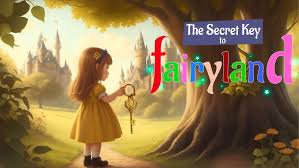One sunny afternoon, Emma was playing in her grandmother’s garden when she noticed something glinting beneath the old oak tree. She knelt down, brushed away the dirt, and pulled out a rusty, golden key.
“A key?” she whispered, turning it over in her hands. “But what does it open?”
Excited, she ran to find her best friends, Noah and Mia, who were building a small fort with sticks and leaves.
“Look what I found!” Emma held up the key, her eyes sparkling.
Noah leaned in. “It looks really old. Maybe it’s for a hidden treasure!”
Mia giggled. “Or a secret door!”
The three friends searched the garden for anything that could fit the key. They checked the tool shed, the back gate, even under the porch, but nothing worked. Just when they were about to give up, Mia spotted something unusual behind a thick wall of ivy near the back of the garden.
“Wait! What’s that?” she pointed.
They pushed aside the leaves and gasped. Behind the ivy was a small, wooden door, barely visible. The keyhole was just the right size for Emma’s key.
Emma took a deep breath and inserted the key. It fit perfectly.
The door creaked open, revealing a hidden room filled with dusty bookshelves, wooden chests, and paintings of children playing. In the middle of the room stood a large wooden chest with a heart-shaped carving on the lid.
“This must have belonged to someone very special,” Noah whispered.
Emma carefully lifted the lid. Inside were old storybooks, colorful puzzles, tiny wooden figurines, and jars filled with beads and paints. Everything looked untouched for years.
Mia picked up a book and flipped through the pages. “Look at this! It’s filled with adventure stories.”
Emma beamed. “This must have been my grandmother’s secret playroom when she was a child.”
Just then, they heard footsteps. Emma’s grandmother peeked inside, her eyes widening.
“Oh my,” she said softly. “You found it.”
“You knew about this?” Emma asked in surprise.
Her grandmother chuckled. “I used to spend hours in here with my friends, just like you. But as I got older, I forgot about it. I always hoped someone would find it again.”
Emma, Noah, and Mia looked at each other, then back at the room.
“Can we use it?” Noah asked eagerly.
Grandmother smiled. “Of course! A place like this is meant to be filled with laughter and imagination.”
From that day on, the little hidden room became their magical clubhouse. They read stories, created paintings, and made up thrilling adventures. And every time they unlocked the door, they were reminded that sometimes, the best treasures aren’t gold or jewels—but the memories we make with friends.
Moral: Some treasures last forever—especially the ones we share with friends.
Kids and Health
What is lactose intolerance?
Lactose intolerance is when someone has trouble digesting lactose, a type of sugar found in milk and other dairy foods.
If people with lactose intolerance eat dairy products, the lactose from these foods pass into their intestines, which can lead to gas, cramps, a bloated feeling, and diarrhea.
Some people can have small amounts of dairy without problems. Others have a lot of stomach trouble and need to avoid all dairy products. Many foods, drinks, and digestive aids are available to help manage lactose intolerance.
What happens in lactose intolerance?
Normally, when we eat something containing lactose, an enzyme in the small intestine called lactase breaks it down into simpler sugar forms called glucose and galactose. These simple sugars are then absorbed into the bloodstream and turned into energy.
In lactose intolerance, the body doesn’t make enough lactase to break down lactose. Instead, undigested lactose sits in the gut and gets broken down by bacteria, causing gas, bloating, stomach cramps, and diarrhea.
Lactose intolerance is fairly common. Kids and teens are less likely to have it, but many people eventually become lactose intolerant in adulthood. Some health care providers view lactose intolerance as a normal human condition and not a disease or serious health problem.
Besides age, people can become lactose intolerant due to: Ethnic background. People of Asian, African, Native American, and Hispanic backgrounds are more likely to develop lactose intolerance at a young age.
Other problems with the digestive tract. People who have inflammation of their upper small intestine, such as celiac disease or Crohn’s disease, have less of the lactase enzyme.
Medicines. Some antibiotics can trigger temporary lactose intolerance because they affect how the intestine makes lactase.
Infection. After a bout of infectious diarrhea, some people can develop a temporary lactose intolerance that usually improves after a few days or weeks.
What are the signs & symptoms of lactose intolerance?
Lactose intolerance can cause a variety of symptoms. It all depends on how much dairy or milk-containing foods people consume and how little lactase their body makes.
How Is Lactose Intolerance Diagnosed?
If you might have lactose intolerance, the docto will ask your symptoms and diet. They might test the breath for hydrogen levels before and after you drink lactose. Normally very little hydrogen gas is detectable in the breath. But undigested lactose in the colon breaks down and makes various gases, including hydrogen.
If you have a hydrogen breath test, you’ll blow into a tube for a beginning sample. Then you’ll swallow a drink with lactose in it, wait a while, and breathe into the tube again. You’ll blow into the tube every half hour for 2 hours to measure hydrogen levels. The levels should go up over time if you have lactose intolerance.
How is lactose intolerance treated?
People can manage lactose intolerance by not drinking as much milk and eating fewer dairy products. Most can eat a small amount of dairy. But they need to eat it with other foods that don’t contain lactose and not eat too much dairy at once.
You may find that other dairy products, such as yogurt and cheeses, are easier to digest than milk. Lactose-free milk is also a great way to get calcium in the diet without the problems. It can also help to keep a food diary to learn which foods you can or can’t tolerate.
A lactase enzyme supplement can help too. Taking this before you eat foods that contain dairy helps your body digest the lactose sugar in dairy and prevent pain, cramping, bloating, gas, and diarrhea.
What else should I know?
Here are some tips for dealing with lactose intolerance: Choose lactose-reduced or lactose-free milk.
Take a lactase enzyme supplement (such as Lactaid) just before you eat dairy products. These can be taken in drops or tablets and even added directly to milk.
When you do drink milk or eat lactose-containing foods, eat other non-lactose foods at the same meal to slow digestion and avoid problems. (For example, if you are going to have a milkshake, don’t drink it by itself. Have something else with it, like a healthy sandwich.)
Drink juices that are fortified with calcium.
Eat a variety of dairy-free foods that are rich in calcium, such as broccoli, beans, tofu, or soy milk. Consider hard cheeses such as cheddar, which are lower in lactose.
Yogurts that contain active cultures are easier to digest and much less likely to cause lactose problems.
Quiz
1. What is the capital of Lagos State?
2. Who is known as the “Lion of Africa” in Nigerian politics?
3. What is the name of Nigeria’s first television station?
4. Which Nigerian dish is made from yam and eaten with soup?
5. What is the full meaning of NYSC?
6. Which Nigerian artist sang the hit song Last Last?
7. What year did Nigeria gain independence?
Answers: 1. Ikeja 2. Chief Obafemi Awolowo 3. Western 4. Nigeria Television (WNTV)
5. Pounded yam 6. National Youth Service Corps 7. Burna Boy 8. 1960
Did You Know?
1. The Great Wall of China is visible from space.
2.A single elephant tooth can weigh as much as 9 pounds.
3. The human body has about 37.2 trillion cells.
4. The only continent with no desert is Europe.
5.The shortest war in history lasted 38 to 45 minutes between Britain and Zanzibar in 1896.
6. The fingerprints of each person are unique—even identical twins have different ones.
7. A lightning bolt is five times hotter than the surface of the sun.



